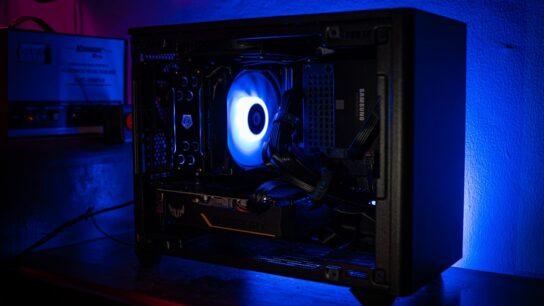The Laserdisc player, also known as the MCA DiscoVision in its early days, was first introduced to the market in 1978. It was the first optical disc storage medium, preceding the DVD and Blu-ray formats. The Laserdisc was a breakthrough in home entertainment technology, offering superior video and audio quality compared to VHS tapes. It was also the first format to offer widescreen movies and bonus features, making it a favorite among cinephiles and home theater enthusiasts.
However, despite its technological advancements, the Laserdisc player never achieved mainstream success. The high cost of both the players and the discs themselves, as well as the cumbersome size of the discs, limited its appeal to a niche market. Additionally, the introduction of the DVD format in the late 1990s quickly overshadowed the Laserdisc, offering similar video and audio quality in a more compact and affordable package. As a result, production of Laserdisc players and discs ceased in 2001, marking the end of an era for this once-revolutionary technology.
The demise of the Laserdisc player was also attributed to its limited playback time per side, which required viewers to flip the disc halfway through a movie. This inconvenience, coupled with the rise of DVD players and later streaming services, ultimately led to the decline of the Laserdisc format. Despite its brief reign in the home entertainment industry, the Laserdisc player left a lasting impact on the evolution of digital media and paved the way for future advancements in optical disc technology.
Key Takeaways
- Laserdisc players were popular in the 1980s and 1990s but eventually fell out of favor due to the rise of DVDs and other digital media.
- There has been a recent resurgence of interest in laserdiscs, with collectors and enthusiasts seeking out rare and unique titles.
- The appeal of laserdisc players in the digital age lies in their analog charm, large format, and unique audio and visual quality.
- Nostalgia plays a significant role in the return of physical media, with many people seeking out laserdiscs for their retro appeal.
- The collector’s market for laserdiscs is thriving, with rare and sought-after titles fetching high prices among enthusiasts.
- The future of the laserdisc player in home entertainment remains uncertain, but its appeal to collectors and enthusiasts is likely to endure.
- Tips for starting or building a laserdisc collection include researching rare and valuable titles, investing in a quality player, and connecting with other enthusiasts for advice and recommendations.
The Resurgence of Interest in Laserdiscs
In recent years, there has been a surprising resurgence of interest in Laserdiscs among collectors and enthusiasts. This renewed fascination with the format can be attributed to several factors, including nostalgia for a bygone era of home entertainment, appreciation for the unique qualities of Laserdiscs, and a growing interest in physical media in an increasingly digital world.
Many collectors are drawn to the large, vinyl-like discs and their iconic artwork, which often featured stunning cover art and exclusive bonus features not found on other formats. The tactile experience of handling and playing a Laserdisc also holds a certain appeal for those who appreciate physical media in an age dominated by digital streaming. Additionally, the superior audio and video quality of Laserdiscs continues to attract cinephiles and audiophiles who value high-fidelity playback.
Furthermore, the limited availability of certain films and special editions on Laserdisc has made them highly sought after by collectors. Some movies were only released on Laserdisc and never made available on DVD or Blu-ray, adding to the allure of building a comprehensive collection. As a result, a dedicated community of Laserdisc enthusiasts has emerged, sharing their passion for the format through online forums, social media groups, and specialized conventions.
The resurgence of interest in Laserdiscs has also been fueled by a growing appreciation for vintage technology and analog aesthetics. As vinyl records have experienced a renaissance in recent years, so too have other analog formats like cassette tapes and, to some extent, Laserdiscs. This newfound appreciation for retro technology has led to a renewed interest in collecting and preserving these artifacts from a bygone era of home entertainment.
The Appeal of the Laserdisc Player in the Digital Age
In an age dominated by streaming services and digital downloads, the appeal of the Laserdisc player may seem perplexing to some. However, for a dedicated community of enthusiasts, the analog charm and unique qualities of the Laserdisc format continue to hold significant appeal in the digital age.
One of the key attractions of the Laserdisc player is its ability to provide a tangible and immersive viewing experience that is often lacking in digital formats. The act of physically inserting a large disc into a player, carefully handling it, and watching it spin as it plays back a movie or concert creates a sense of ritual and engagement that is absent from simply clicking “play” on a streaming platform. This tactile interaction with physical media adds an element of nostalgia and authenticity to the viewing experience that many collectors find deeply satisfying.
Furthermore, the superior audio and video quality of Laserdiscs continues to be a major draw for enthusiasts who value high-fidelity playback. Despite being an analog format, Laserdiscs are capable of delivering stunning picture quality and uncompressed audio that rivals or even surpasses some digital formats. This level of audiovisual fidelity is particularly appealing to cinephiles and audiophiles who prioritize the quality of their home entertainment experience.
Another aspect that contributes to the appeal of the Laserdisc player in the digital age is its ability to offer exclusive bonus features and alternate versions of films that are not readily available through streaming services or digital downloads. Many Laserdisc releases included behind-the-scenes documentaries, director’s commentaries, and other supplemental material that are not always included in modern home video releases. For collectors and film enthusiasts, these additional features add value to their physical media collections and provide a deeper understanding and appreciation of their favorite films.
Nostalgia and the Return of Physical Media
| Year | Physical Media Sales | Streaming Subscribers |
|---|---|---|
| 2015 | 13.1 billion | 24 million |
| 2016 | 10.3 billion | 46 million |
| 2017 | 8.9 billion | 74 million |
| 2018 | 7.8 billion | 110 million |
| 2019 | 6.3 billion | 167 million |
The resurgence of interest in physical media, including Laserdiscs, can be attributed in part to a broader cultural nostalgia for analog technology and tangible artifacts from the past. In an era where digital content is ubiquitous and often intangible, there is a growing desire among many individuals to reconnect with physical objects that evoke memories of a simpler time.
For many collectors, owning and displaying physical media such as Laserdiscs represents a form of nostalgia for an era when home entertainment was centered around tangible objects like vinyl records, cassette tapes, and VHS tapes. The act of browsing through shelves of discs, carefully selecting one to play, and admiring the artwork on the cover can evoke feelings of nostalgia for a time when physical media played a central role in people’s lives.
Additionally, physical media offers a sense of permanence and ownership that is often lacking in digital formats. With streaming services and digital downloads, content can come and go based on licensing agreements and technological advancements. In contrast, owning a physical copy of a film or album provides a sense of security and stability, allowing collectors to build a personal archive of their favorite works that can be enjoyed for years to come.
Furthermore, the tactile nature of physical media appeals to our senses in a way that digital content cannot replicate. The act of handling a Laserdisc, feeling its weight and texture, and admiring its artwork engages our senses in a way that clicking “play” on a digital file does not. This multisensory experience adds depth and richness to the act of consuming media, making physical media an appealing option for those seeking a more immersive and tangible connection to their favorite films and music.
The Collector’s Market for Laserdiscs
The collector’s market for Laserdiscs has experienced significant growth in recent years as enthusiasts seek out rare and sought-after titles to add to their collections. With the format’s limited production run and unique qualities, certain Laserdisc releases have become highly coveted by collectors, leading to a thriving secondary market for these discs.
One factor driving the collector’s market for Laserdiscs is the scarcity of certain titles, particularly those that were only released on Laserdisc and never made available on DVD or Blu-ray. These exclusive releases have become prized possessions for collectors seeking to own unique pieces of cinematic history that are not easily accessible through other formats. As a result, rare or out-of-print Laserdiscs can command high prices on the secondary market due to their scarcity and desirability among collectors.
Additionally, special edition releases with unique packaging or bonus features have also become sought after by collectors looking to acquire distinctive versions of their favorite films. Limited edition box sets, director’s cut editions, and foreign imports are highly prized by enthusiasts seeking to build comprehensive collections that showcase the diversity and artistry of the format.
Furthermore, certain genres or niche interests have contributed to the growth of the collector’s market for Laserdiscs. Cult classics, obscure foreign films, concert recordings, and rare documentaries are just some examples of sought-after genres that appeal to collectors with specific tastes and interests. As a result, these specialized releases have become valuable additions to many collectors’ libraries as they seek to curate unique and diverse collections that reflect their individual passions.
The Future of the Laserdisc Player in Home Entertainment

While it may seem unlikely that an obsolete format like the Laserdisc player would have a future in home entertainment, there are indications that it continues to hold relevance for a dedicated community of enthusiasts. Despite being overshadowed by more advanced digital formats like Blu-ray and streaming services, there are several factors that suggest the continued presence of Laserdisc players in home entertainment setups.
For many collectors and enthusiasts, owning a working Laserdisc player represents an opportunity to experience films in their original analog format with unparalleled audiovisual quality. The unique characteristics of Laserdisc playback, including its large format size and analog playback mechanism, offer a distinct viewing experience that cannot be replicated by digital formats. As such, there remains a niche market for functional Laserdisc players among those who value authenticity and historical significance in their home entertainment setups.
Furthermore, as with other vintage technologies like vinyl records and analog audio equipment, there is an enduring appeal for retro aesthetics and analog experiences that contribute to the continued relevance of Laserdisc players. The tactile nature of handling large discs, carefully placing them into a player, and watching them spin as they play back movies or concerts evokes a sense of nostalgia and authenticity that resonates with many enthusiasts seeking a more immersive viewing experience.
Additionally, as with any niche hobby or interest, there is a dedicated community of enthusiasts who actively collect, maintain, and celebrate the legacy of Laserdisc players. Through online forums, social media groups, specialized conventions, and local meetups, these enthusiasts continue to share their passion for vintage technology while also preserving its cultural significance for future generations.
Tips for Starting or Building a Laserdisc Collection
For those interested in starting or expanding their collection of Laserdiscs, there are several tips to consider when navigating this niche market.
Firstly, it’s important to research and familiarize oneself with different releases, editions, and special features available on Laserdiscs. Understanding which films were exclusively released on this format or which editions contain unique bonus material can help collectors prioritize their acquisitions based on their individual interests.
Secondly, it’s advisable to seek out reputable sources for purchasing Laserdiscs such as specialized online retailers, collector forums, or local record stores with dedicated sections for vintage media. These sources often offer curated selections of rare or sought-after titles along with valuable insights from fellow enthusiasts.
Additionally, it’s essential to carefully inspect any potential purchases for signs of wear or damage such as disc rot or scratches that may affect playback quality. Given the age and fragility of some Laserdiscs, it’s important to ensure that any acquisitions are in good condition to guarantee an optimal viewing experience.
Furthermore, joining online communities or attending local meetups dedicated to Laserdisc collecting can provide valuable opportunities to connect with fellow enthusiasts who can offer advice on building a collection or share recommendations for must-have titles.
Finally, it’s important to approach collecting with an open mind and willingness to explore diverse genres or obscure releases that may not be readily available through mainstream channels. Embracing the diversity and uniqueness of the format can lead to discovering hidden gems that enrich one’s collection with rare or unconventional titles.
In conclusion, while the era of widespread adoption for Laserdisc players may have come to an end with the rise of digital formats like DVD and Blu-ray, there remains a dedicated community of enthusiasts who continue to celebrate this pioneering technology. The resurgence of interest in Laserdiscs reflects a broader cultural nostalgia for analog technology and physical media while also highlighting the enduring appeal of vintage aesthetics and immersive viewing experiences. As such, the future of the Laserdisc player in home entertainment may be niche but remains relevant for those who value authenticity, historical significance, and high-fidelity playback in their pursuit of cinematic enjoyment.
If you’re interested in learning more about vintage technology, you might want to check out this article on ModelSurfing about the history and evolution of the laserdisc player. This article provides a comprehensive overview of the laserdisc player’s development and its impact on home entertainment. It’s a fascinating read for anyone interested in the intersection of technology and media.
FAQs
What is a laserdisc player?
A laserdisc player is a device used to play laserdiscs, which are a type of home video format that was popular in the 1980s and 1990s.
How does a laserdisc player work?
A laserdisc player uses a laser to read the information encoded on a laserdisc. The disc is spun at high speed while the laser reads the information, allowing the player to display video and audio content.
What are the advantages of a laserdisc player?
Laserdisc players were known for their high-quality video and audio playback, as well as their ability to display widescreen and high-definition content.
What are the disadvantages of a laserdisc player?
Laserdisc players were large and bulky, and the discs themselves were also quite large and heavy. Additionally, laserdiscs were not as durable as other home video formats, and they were prone to damage from scratches and fingerprints.
Is it still possible to buy a laserdisc player?
Laserdisc players are no longer being manufactured, but it is still possible to find them for sale on the secondary market, such as through online auction sites or specialty electronics retailers.
Are laserdisc players still used today?
While laserdisc players are no longer a popular home video format, there are still some enthusiasts who collect and use laserdisc players and discs for their high-quality audio and video playback.



